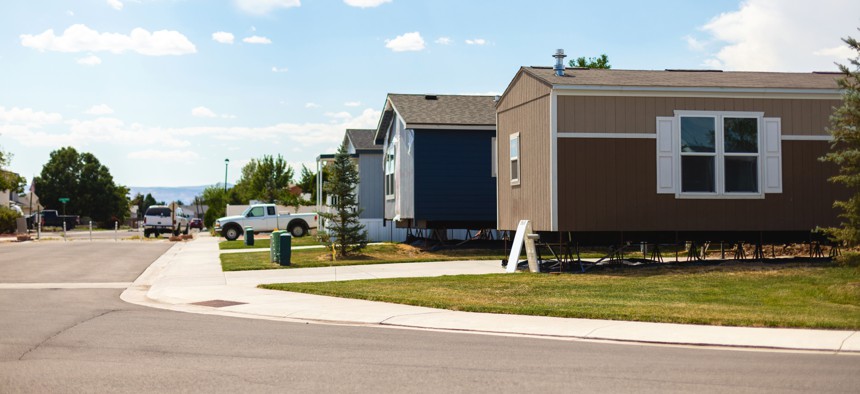Investors are buying mobile home parks. Residents and governments are pushing back.

eyecrave productions
Amid an affordable housing crisis, some states are looking to help low-income residents stay in their homes by helping them purchase the land their manufactured housing sits on.
In 2021, a California-based investor group purchased Golden Hill Mobile Home Park in Golden, Colorado, a small city just outside Denver in the foothills of the Rocky Mountains. Less than two years later, rents doubled for the nearly 40 households that called the community home, pushing residents—some that had lived there for decades—to seek cheaper alternatives in an area already feeling the pressure of an affordable housing crisis.
But this week, residents of the Golden Hills community got some good news: They are now the owners of the land their homes sit on, thanks in part to a 2020 state law that gave them the opportunity to purchase the property with financial assistance from the city and nonprofits.
Manufactured housing communities like the one in Golden are considered some of the most affordable unsubsidized housing in the country. But between rising rents and deep-pocketed investors scooping up these communities, residents are increasingly looking to purchase the land itself, and governments at all levels are mobilizing to help them do so.
More than 20 million Americans live in manufactured housing, according to the Manufactured Housing Institute, a trade association. With the average single-section manufactured home clocking in at just over $86,000, many residents cite affordability as the primary reason for purchasing the housing.
But while people may own these homes, they typically rent the land the buildings sit on. Just like any rental, those monthly payments are subject to rent increases as determined by the property owners. Last year, the average increase was just over 6%, according to the Manufactured Housing Institute, compared to 12% for new apartment tenants and 3.5% for apartment tenants who renewed their leases.
Large rent increases in manufactured housing communities often come after the property has been sold, according to Paul Bradley, president of ROC USA, a nonprofit that helps manufactured housing communities purchase properties. Over the last decade, private equity firms have increasingly invested in mobile home communities, much like they have in single-family homes. The Lincoln Institute estimates that about one-fifth of manufactured housing communities, or 800,000 home sites, have been purchased by investors in the previous eight years. (Manufactured housing is often called mobile home parks, though technically “mobile homes” are factory-built houses constructed before 1976.)
To ward off the trend, mobile park communities across the county have formed cooperatives in order to purchase the properties themselves. On Monday, Golden Hills Mobile Home Park became the 311th community to be purchased by its residents and the sixth in Colorado, according to ROC USA. These communities have a high success rate, Bradley said. So far, none have defaulted on their loan, declared bankruptcy or sold the property back to the private market. That may be, in part, because in the long run monthly payments are more stable compared to rents paid to private owners.
Governments at all levels have been mobilizing in recent years to better support residents of manufactured housing, especially low-income households.
Take, for instance, the Minnesota Legislature, which recently passed what Bradley described as “unprecedented” legislation. The law, among other things, preserves manufactured housing communities by creating a $10 million acquisition fund to help park residents purchase their communities, a $15 million fund for redevelopment and infrastructure improvement projects, and $10 million to help people purchase manufactured homes. It is, Bradley says, “the most comprehensive set of investments in residential communities and manufactured housing communities anywhere in the country.”
Another power tool states are turning to is legislation that gives residents the first opportunity to buy the property their homes sit on. In recent weeks, Connecticut and Maine have enacted such bills. In 2020, Colorado approved a similar bill that has already helped preserve several mobile home parks in the state.
One such example is a manufactured housing community in Durango, Colorado, where the land was being sold as part of a 95-property portfolio deal to an investor group in Maryland. But the state’s opportunity to purchase law gave residents the ability to put in an offer.
In total, 19 states have so-called right to first refusal laws, according to the Manufactured Housing Institute. These laws vary across states. For instance, in some cases they only apply when the land for sale would be converted to something other than a manufactured housing property. They also vary in how much they benefit tenants, Bradley said. In Washington state, the penalty for owners who don’t give residents enough time to organize is almost negligible, and sellers can just increase the property price to cover those fees.
For manufactured housing, the concept of residents owning the land or cooperatives isn’t new. Such communities have been around since the 1970s, according to Bradley, and first flourished in California, Florida and New Hampshire.
The Granite State’s model, in particular, is uniquely poised to benefit low-income residents through a shared equity model. The movement gained more momentum in 1988, when the state approved a right of first refusal law. A few other states, including Massachusetts and Vermont, enacted similar legislation in the years following, but there has been very little action until recently.
Critics of right to first refusal laws often argue that the amount of time residents have to organize and purchase a property can deter other potential buyers and interfere with the seller’s private property rights. Even if residents end up purchasing the land, running and investing in a community is a major undertaking.
“They have set up a business together, and it's run on a democratic basis,” Bradley said, adding that it can be difficult for some communities to find volunteers who are willing to sit on a community leadership board.
In many cases, aged infrastructure presents the most pressing challenges to resident-owned communities. Many manufactured housing properties were established several decades ago and require significant infrastructure upgrades for services like water and sewage.
To help address these issues, Congress included a new Preservation and Reinvestment Initiative for Community Enhancement (PRICE) fund in the omnibus law Congress passed in December. The initiative includes $225 million in grants to support infrastructure and service projects, and will go to resident-owned communities, local governments, nonprofits and other entities committed to the long-term affordability of manufactured housing.
Finding property managers to help residents maintain their communities can also be a major challenge, as there are many more managers with the willingness and experience to take on multifamily housing, say, rather than manufactured housing.
But that’s changing, Bradley said. “The good news is as there are more co-ops there are more property managers coming along that are interested in co-ops.”
Editor's note: This story was changed July 11 to correct the number of manufactured housing sites purchased by investors over the last decade.






